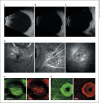Unilateral Multifocal Choroidal Melanoma
- PMID: 29344499
- PMCID: PMC5757552
- DOI: 10.1159/000478102
Unilateral Multifocal Choroidal Melanoma
Abstract
We report a case of multifocal choroidal melanoma in the same eye, separated in presentation by 20 years. A 57-year-old Caucasian male initially presented with a choroidal melanoma of the right eye that was treated with transpupillary thermotherapy. Due to recurrence, the patient underwent proton beam therapy with subsequent tumor regression. A second small choroidal lesion was noted in the right eye during his surveillance examinations that was closely monitored and demonstrated stable dimensions and features suggestive of a choroidal nevus. Twenty years after his first presentation, the second lesion exhibited accelerated growth with imaging studies indicative of transformation to a distinct choroidal melanoma. The patient underwent a second globe salvage treatment of proton beam therapy. We describe the clinical course, radiographic, and imaging findings of this rare choroidal melanoma.
Keywords: Choroidal melanoma; Melanoma; Multifocal melanoma; Optical coherence tomography angiography; Proton beam radiotherapy; Tumor recurrence.
Figures


References
-
- Singh AD, Turell ME, Topham AK. Uveal melanoma: trends in incidence, treatment, and survival. Ophthalmology. 2011;118:1881–1885. - PubMed
-
- Singh AD, Shields CL, Shields JA, De Potter P. Bilateral primary uveal melanoma. Bad luck or bad genes? Ophthalmology. 1996;103:256–262. - PubMed
-
- Shammas HF, Watzke RC. Bilateral choroidal melanomas. Case report and incidence. Arch Ophthalmol. 1977;95:617–623. - PubMed
-
- Honavar SG, Shields CL, Singh AD, et al. Two discrete choroidal melanomas in an eye with ocular melanocytosis. Surv Ophthalmol. 2002;47:36–41. - PubMed
LinkOut - more resources
Full Text Sources
Other Literature Sources

